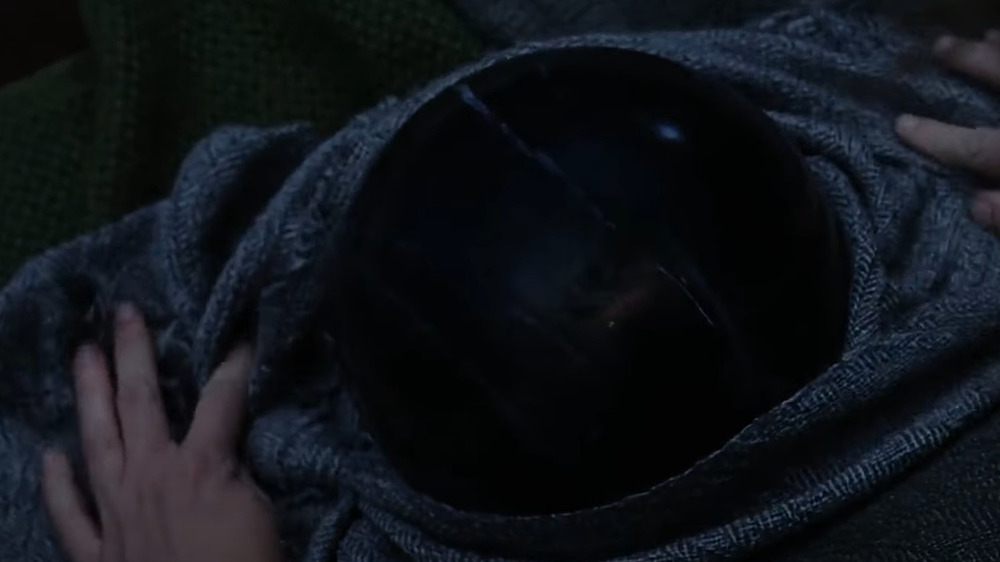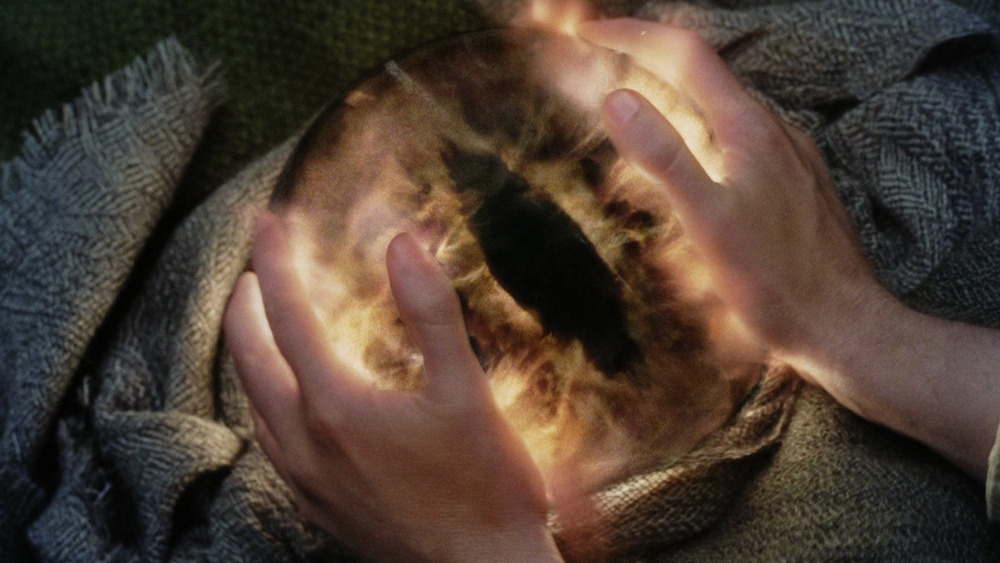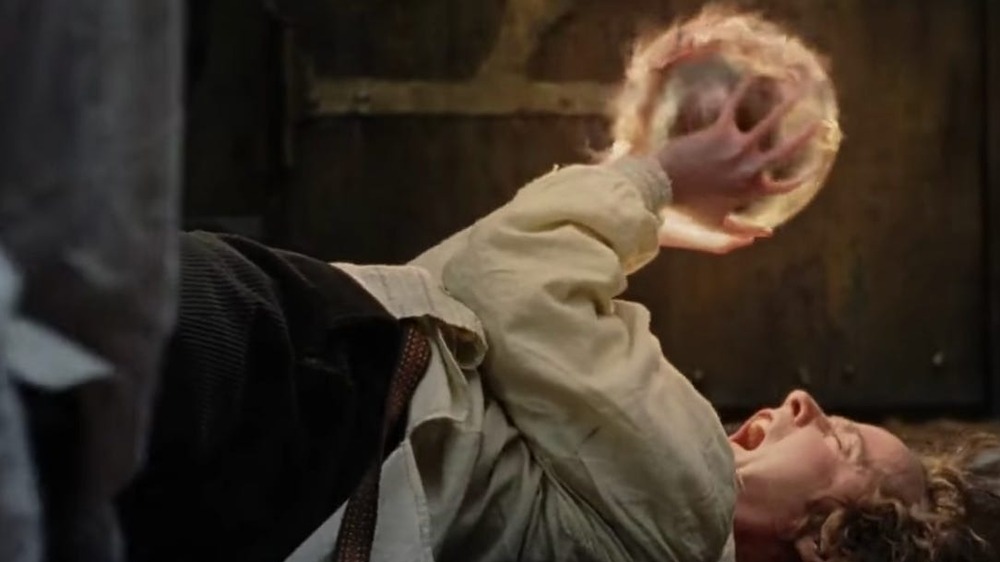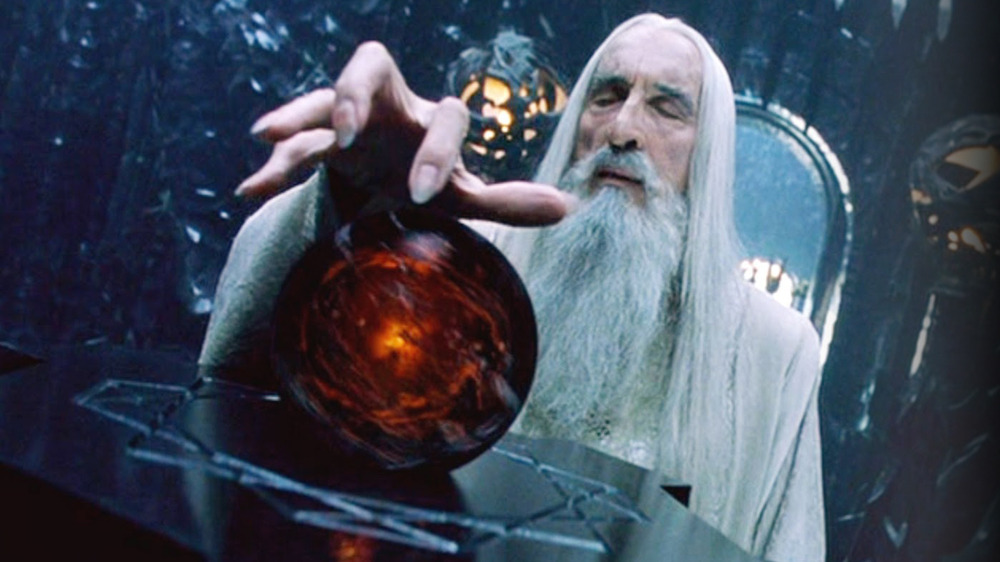The Palantiri: Tolkien's Seeing Stones Explained
Middle-earth is filled with all sorts of strange items and possessions. Necklaces, gems, weapons, and, of course, rings all feature prominently in J.R.R. Tolkien's stories. In spite of all of the enchanted trinkets hanging around, there's one super-powered curio that doesn't really get its fair share of attention: the palantíri. It's a strange title that fairweather fans of Peter Jackson's Lord of the Rings films probably won't even recognize. We're talking about the globular item that Saruman uses to communicate with Sauron. Fans of the books will find the palantíri more familiar — particularly since a chapter in The Two Towers is named after the strange devices. Even so, unless you do some serious digging into Tolkien's extracurricular writings in The Silmarillion and Unfinished Tales, it's difficult to really understand what these glowing globes are.
The Silmarillion tells us that the name "palantír" means "those that watch from afar." Tolkien also explained that there were initially seven Seeing Stones in circulation. They came in different sizes, with some as small as a foot in diameter and others too big for a man to carry. In Unfinished Tales, it describes that "they were perfect spheres, appearing when at rest to be made of solid glass or crystal deep black in hue." It also informs us that they were unbreakable by any man-made violence — even though some thought that, just like the One Ring, the one exception was that they could be shattered by the fires of Mount Doom.
Looks and size aside, what is the story behind these strange artifacts? We decided to dig a little deeper into the backstory of the palantíri in order to figure out a little bit more about their history, how they worked, and how they featured in Tolkien's original writings. Here's what we found.
The history of the Stones
One of the biggest reasons that we hear very little about the palantíri is that, by the time of The Lord of the Rings, the Seeing Stones are a forgotten part of Middle-earth history. In Unfinished Tales, it states that the Stones were "never matters of common use or common knowledge." In other words, your average Joe bumming around Middle-earth didn't go around hobnobbing and chatting about the latest news regarding the local palantír. Even at their best, the Seeing Stones were topics reserved for kings, stewards, and other leaders.
In spite of their classified status, Tolkien gives us quite a bit of detail about how these stones came into being. The "Seeing Stones" are created by his famous character Fëanor. The Elvish craftsman forges the Stones far to the west of Middle-earth in the Blessed Realm. This happens many thousands of years before the War of the Ring. It also seems that there are many of these Seeing Stones made in the Blessed Realm, and a Mastertone is even referenced at one point.
However, in the Second Age — still, thousands of years before the events of The Lord of the Rings — seven of these Stones are gifted to the Men living on the island nation of Númenor halfway between the Blessed Realm and the continent of Middle-earth. This means the Stones could end up being a huge factor in Amazon's Middle-earth show since the Men of Númenor will definitely be a central part of the story.
The palantíri stay safe in Númenor for centuries. When the island nation is destroyed towards the end of the age, the survivors of the wreckage bring the Stones to Middle-earth. At that point, they get a new function as they're distributed amongst the newly minted kingdoms of Gondor in the south and Arnor in the north.
The Seeing Stones on the Mainland
After a relatively quiet early history spent on the island of Númenor, the palantíri become much more important when they're relocated to the mainland of Middle-earth. Here, they're split up and placed in seven key locations throughout Arnor and Gondor. The ability of the Stones to communicate with one another (more on that in a minute) is particularly important, as it helps keep all of the Númenoreans in close contact in spite of their sprawling new domains.
Over time, some of the Stones are moved, or end up in obscure locations that only the most die-hard Middle-earth nerds could identify. However, several of them end up spending time in locations that are immediately recognizable. For instance, one is kept on Weathertop right in the tower that is later seen in its ruined form when Frodo is stabbed by the Witch-king. Another Stone is kept in the tower of Orthanc in Isengard. Saruman, anyone? A third is lodged in Minas Ithil — the tower that later becomes the home base of the Ringwraiths. A fourth is kept in Minas Tirith, which becomes a temptation to Denethor, as we'll see in a minute.
A massive Stone is also kept in Osgiliath, the capital city of Gondor at the time. This is the ruined city that we see Faramir's outnumbered forces fail to defend early in The Return of the King. When that city is initially destroyed in a civil war, the master Seeing Stone that is kept there is lost in the river that runs through the metropolis. In fact, while the Númenóreans start with seven Seeing Stones, eventually, all but two of them are lost in the ongoing wars and catastrophes of Middle-earth.
Stone Powers and Abilities
In The Silmarillion, it explains that those who look in the Stones could "perceive in them things far off, whether in place or in time. For the most part, they revealed only things near to another kindred Stone, for the Stones each called to each." It also adds that "those who possessed great strength of will and of mind might learn to direct their gaze whither they would." In other words, the palantíri are Seeing Stones that allow users to see each other and, for the strongwilled, even let them look wherever they want to. They can even look across time, which is a pretty sweet trick to have up your sleeve.
J.R.R.Tolkien explains in Unfinished Tales that when using a Stone to talk with another Stone, the speaker would use mental communication, but the thoughts were "received as speech." Two Stones had to be aimed at one another to speak together. The master Stone in Osgiliath is uniquely powerful, too, and anyone using that could actually "eavesdrop" on other Stone-based conversations, as well.
The Stones could do more than just act like magical walkie-talkie orbs, though. They also allowed strong-willed users to see all over the world and time. Tolkien once again gives us an unusually descriptive explanation of how this worked, especially in Unfinished Tales. He explains that the Stones could see through solid objects like a mountain, but they needed light to be able to actually see a space. The book also explains that the Stones "could not themselves survey men's minds, at unawares or unwilling." It also references a forgotten art known as "shrouding," which could block someone from a Seeing Stone, making their immediate area appear as "a shadow or a deep mist."
The Stones in the hands of the bad guys
The Seeing Stones have a minor role in Peter Jackson's adaptation of The Lord of the Rings. However, in the books, the magical tools play a much heftier part — both with the good and the bad guys. Let's start with the baddies, shall we?
Roughly a thousand years before the War of the Ring, the Ringwraiths capture the Gondorian fortress of Minas Ithil. This is the ghastly city that Frodo, Sam, and Gollum pass on their way up to Shelob's lair. When Minas Ithil is captured, no one officially finds out what happened to the palantír that was housed there. However, the wise leaders in Gondor decide that they should stop using their Stones, since the Nazgul — and more importantly, their master Sauron — may have captured it. This is a good call, as the Lord of the Rings does indeed end up with that Stone and uses it to destructive effect on more than one occasion in the future.
The other villain seen using a palantír on multiple occasions is Saruman. This is the one spot where the palantíri clearly make it into Jackson's adaptation. How does Saruman come by his Stone, you ask? Of course, that's when he's given the guardianship of the originally Gondorian fortress of Isengard and its tower of Orthanc about 250 years before the War of the Ring. When that happens, he finds the Stone which had probably been stuffed away for safekeeping after Sauron got his heinous hands on its sibling.
The Gondorians undoubtedly thought that the White Wizard would be a good guardian of such a valuable antique. However, hindsight is 20/20, right? Saruman eventually starts to use the Stone to secretly gather knowledge. From there, it isn't long before his magically magnified gaze is caught by Sauron, who begins the process of dominating the power-hungry wizard.
The Stones in the hands of Denethor
While the Seeing Stones have a pretty bad rap sheet in the hands of Sauron and Saruman, they do see some use by the good guys, too. Pippin innocently uses the Orthanc Stone, helping to reveal what it is and saving Gandalf from accidentally exploring the Stone and being caught by Sauron. However, the Hobbit isn't the only one.
The Steward Denethor also uses a palantír early and often. In fact, in Unfinished Tales, it says that "he began to use the [Minas Tirith Stone]... earlier than Saruman." This crucial detail is left out of the movies, giving the leader of Gondor a strange, unexplained defeatist attitude. In the books, though, it is eventually revealed that Denethor has been using a Stone to collect knowledge. Like Saruman, he was also caught by Sauron. However, unlike the wizard, Denethor was not subdued to the will of the Dark Lord. Instead, Sauron used the mental connection to attack the steward's confidence. He warps his view of the Dark Lord's power and feeds a growing narrative in his mind that the war against Mordor is utterly and completely hopeless. This makes Denethor depressed, desperate, and emotionally fragile. When Faramir is hurt by Denethor's own orders, it proves to be the straw that breaks the camel's back.
The other good guy to handle a Seeing Stone is none other than Aragorn himself. The rightful heir to the throne of Gondor puts on a show by wrenching the Orthanc Stone from its long-developed connection to Sauron. He then uses the opportunity to scare the villain by showing him the reforged sword that chopped off his ring finger an age earlier. From there, Aragorn uses the Stone to look around. Seeing the Black Ships attacking Gondor from the south, he's convinced to make the crucial decision to take the Paths of the Dead. And scene.





